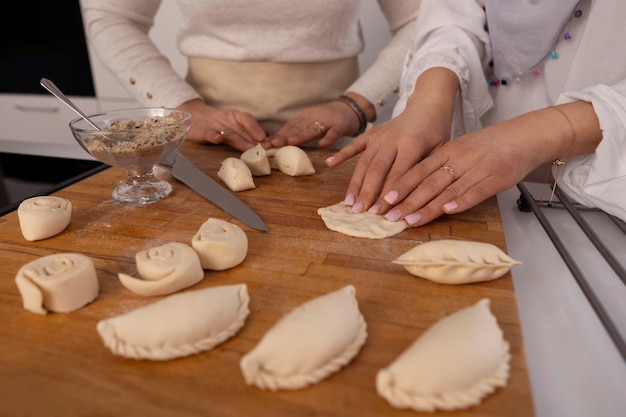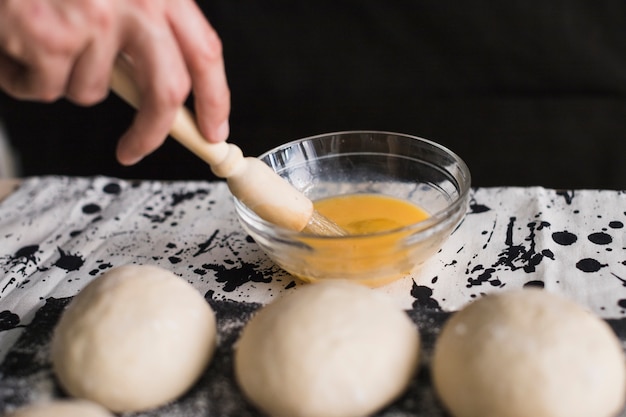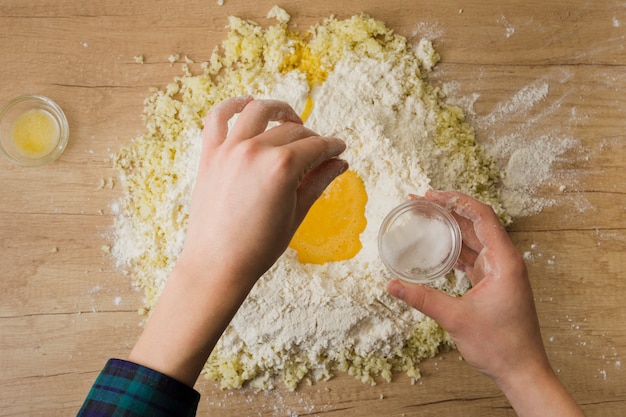There's nothing quite like the pure joy of sinking your teeth into a plate of homemade ravioli. The delicate pasta, the bursting flavours of the filling, and the rich sauce – it's a symphony of culinary perfection. I've been making ravioli for years, and it's a dish that never fails to impress, whether I'm hosting a dinner party or simply treating myself to a delicious meal. It's become a cherished tradition in my kitchen, and I love sharing the experience with friends and family. So, if you're feeling adventurous in the kitchen, or simply fancy a change from your usual pasta routine, grab your rolling pin and get ready to embark on a culinary journey with me. Trust me, making ravioli from scratch is easier than you might think!
(Part 1) The Joy of Homemade

I've always loved cooking, and pasta making has a special place in my heart. There's something so satisfying about transforming simple ingredients into something truly delicious. I remember the first time I made ravioli. I was a bit nervous, but the process was surprisingly straightforward. Plus, the feeling of accomplishment when you take a bite of your own homemade pasta is just indescribable. It's not just about the taste; it's about the journey, the connection with the food, and the sense of pride that comes with creating something special from scratch.
A Touch of Nostalgia
Making ravioli reminds me of my grandmother's kitchen, filled with the aroma of simmering tomato sauce and the rhythmic thump of dough being kneaded. Her kitchen was a haven of warmth and love, a place where family gathered to share meals and stories. She taught me the importance of using fresh, quality ingredients and taking the time to get things right. For her, cooking wasn't just about preparing a meal; it was an act of love and care. She would always say, "If you put love into your cooking, it will shine through in the taste." I carry that sentiment with me whenever I'm in the kitchen, and it's particularly evident when I'm making ravioli. The act of making ravioli is a way for me to honour her memory and share her love of good food with those I care about.
Embracing the Journey
Sure, you can always grab a packet of store-bought ravioli, but there's a certain magic that happens when you make it yourself. The process becomes an adventure – from kneading the dough to shaping the pasta to filling it with your favourite ingredients. Each step is an opportunity to connect with the food and appreciate the craft involved. The aroma of fresh pasta fills the air, and the feel of the dough in your hands is incredibly grounding. It's a reminder that food is more than just sustenance; it's a celebration of life, creativity, and connection.
(Part 2) Gathering Your Ingredients

Now, let's get down to business and talk about the ingredients you'll need for your ravioli adventure. Don't be intimidated by the list; it's really quite simple. Focus on using high-quality ingredients, as they'll make a world of difference in the final taste and texture of your ravioli.
Pasta Dough Essentials
For the pasta dough, you'll need:
- 2 cups of plain flour, plus extra for dusting – I prefer to use a good quality "00" flour for its smooth texture and ability to absorb moisture, but all-purpose flour will work just fine.
- 3 large eggs – Use fresh eggs, as they will make the dough richer and more flavourful.
- 1/4 teaspoon of salt – Salt enhances the flavour of the dough and helps to prevent it from becoming too sticky.
- 1 tablespoon of olive oil – Olive oil adds a touch of richness and helps to keep the dough from drying out.
These ingredients are readily available at any supermarket, and you can even use organic flour for a more wholesome touch.
Filling Up Your Ravioli
The filling is where you can really get creative. I'm a big fan of classic ricotta and spinach, but you can experiment with different cheese combinations, meats, vegetables, or even seafood. Here's a simple ricotta and spinach filling recipe, but feel free to let your imagination run wild.
- 250g ricotta cheese – Ricotta is a soft, creamy cheese that works beautifully in ravioli fillings. Look for whole milk ricotta for the best flavour.
- 100g spinach, blanched and squeezed dry – Blanching the spinach removes any bitterness and makes it more tender.
- 1 clove garlic, minced – Garlic adds a pungent and aromatic flavour to the filling.
- 1/4 teaspoon of nutmeg – Nutmeg adds a warm, earthy note to the filling, complementing the ricotta and spinach beautifully.
- Salt and black pepper to taste – Season the filling generously with salt and pepper to bring out the flavours.
- Grated Parmesan cheese, for serving (optional) – Parmesan cheese adds a salty, nutty flavour and a touch of richness to the finished ravioli.
Sauce Sensations
And, of course, no ravioli is complete without a delicious sauce. There are endless options here, from classic tomato sauce to rich butter sage sauce or creamy pesto. I'll share a simple tomato sauce recipe later, but feel free to experiment with your own favourites. The sauce is the finishing touch that brings the entire dish together, so choose something that complements the flavours of your filling.
(Part 3) Kneading Your Way to Perfection

Now, let's talk about the heart of the ravioli-making process – the dough. This is where the magic happens. It's a bit like a culinary ballet, with the flour, eggs, and olive oil dancing together to form a smooth, elastic dough. It's a process that requires patience and a little bit of muscle, but the results are worth it.
The Flour Power
Start by creating a mound of flour on a clean surface. Use a fork to make a well in the center, and crack your eggs into it. Add the salt and olive oil to the well. Using the fork, gently whisk the eggs together with the salt and oil. The fork helps to break down the eggs and create a smooth mixture.
Kneading the Dough
Now, it's time to get your hands dirty! Slowly incorporate the flour from the sides of the well into the egg mixture, using your fork or fingers. Once the mixture starts to come together, switch to kneading with your hands. This is where the magic of kneading comes in.
Knead the dough vigorously for about 10 minutes, or until it's smooth and elastic. The gluten in the flour develops during kneading, creating a strong, elastic texture that holds its shape. If the dough feels too sticky, add a little more flour, a tablespoon at a time. If it's too dry, add a few drops of water.
Rest and Relaxation
Once you've kneaded the dough to perfection, wrap it in cling film and let it rest for at least 30 minutes. This will allow the gluten to relax, making the dough more pliable and easier to work with. Resting the dough also helps to develop the flavour and texture of the pasta.
(Part 4) Shaping the Pasta
After your dough has rested, it's time to give it a shape. This is the fun part – you get to create the iconic ravioli squares. It's a bit like playing with clay, but with a much more delicious outcome.
Rolling It Out
Divide the dough into four equal pieces. Dust your work surface with flour and, using a rolling pin, roll out each piece of dough into a thin, even sheet. Aim for a thickness of about 1/16 inch – you want it thin enough to be delicate but not so thin that it tears easily. A light touch is key here, as you want to avoid over-working the dough.
Cutting and Shaping
Once you have your rolled-out dough sheets, you're ready to cut them into squares. You can use a knife or a ravioli cutter for this. I prefer a ravioli cutter for a more uniform shape, but a sharp knife will do the trick just fine.
Place a spoonful of filling onto each square. Don't overfill them, or the filling will ooze out during cooking. Next, brush the edges of the dough with a little water. This will help them stick together.
Joining the Sides
Now, fold the squares in half, and press down firmly along the edges to seal them. You can use a fork to crimp the edges for a decorative touch. Alternatively, use your fingers to pinch the edges firmly.
Repeat this process with all the squares. If you're feeling adventurous, try making different shapes – hearts, circles, or even triangles. Let your creativity flow!
(Part 5) Filling Up Your Ravioli
Let's get to the heart of the matter: the filling! This is where you can unleash your inner chef and experiment with different flavour combinations.
Ricotta and Spinach Delight
For this recipe, we'll be using a classic ricotta and spinach filling. It's simple to make and incredibly delicious.
First, blanch the spinach for a few minutes until wilted. Drain it well and squeeze out all the excess water. Finely chop the spinach. Blanching the spinach removes any bitterness and makes it more tender.
In a bowl, combine the ricotta cheese, minced garlic, nutmeg, salt, and black pepper. Gently stir in the chopped spinach until evenly distributed. You can add some grated Parmesan cheese to the filling for extra flavour.
Other Filling Ideas
If you're looking for other filling options, here are a few ideas:
- Mushroom and Goat Cheese: Sautéed mushrooms with garlic and herbs, mixed with creamy goat cheese. The earthy flavour of mushrooms pairs beautifully with the tangy goat cheese.
- Beef and Parmesan: ground beef seasoned with Italian herbs and spices, combined with grated Parmesan cheese. A classic combination that's sure to please.
- Pumpkin and Sage: Roasted pumpkin puree with sage, nutmeg, and a touch of cinnamon. This filling is perfect for autumn and winter.
- Salmon and Dill: Flaked salmon mixed with fresh dill, lemon zest, and a touch of cream cheese. A light and flavourful option that's perfect for spring.
The possibilities are endless! Don't be afraid to experiment and create your own unique ravioli fillings.
(Part 6) Bringing Your Ravioli to Life
Now, it's time to bring your homemade ravioli to life. The cooking process is quick and simple, and the results are absolutely mouthwatering.
Boiling Bliss
Fill a large pot with salted water and bring it to a boil. Gently drop your ravioli into the boiling water, making sure not to overcrowd the pot. Cook the ravioli for about 3-4 minutes, or until they float to the surface. The ravioli will float to the surface when they are cooked through.
Timing is Everything
Don't overcook the ravioli – you want them to be tender but still have a slight bite. If you're unsure, test one ravioli with a fork – if it's cooked through, the rest should be too.
Draining Delicacy
Once the ravioli are cooked, use a slotted spoon to gently lift them out of the boiling water and drain them. Don't worry if they stick together a little – you can easily separate them later.
(Part 7) A Symphony of Sauce
Now that your ravioli are cooked, it's time to dress them up with a delicious sauce. A simple tomato sauce is always a winner, but you can experiment with other options, like pesto, cream sauces, or even a drizzle of olive oil and melted butter. The sauce should complement the flavour of the filling and add another layer of complexity to the dish.
Tomato Sauce Perfection
For a simple tomato sauce, you'll need:
- 1 tablespoon olive oil – Olive oil adds a richness and depth of flavour to the sauce.
- 1 onion, chopped – Onion adds a sweetness and complexity to the sauce.
- 2 cloves garlic, minced – Garlic adds a pungent and aromatic flavour to the sauce.
- 1 (28-ounce) can crushed tomatoes – Crushed tomatoes provide the base for the sauce. Look for high-quality crushed tomatoes for the best flavour.
- 1/2 teaspoon dried oregano – Oregano adds a classic Italian flavour to the sauce.
- 1/4 teaspoon salt – Salt enhances the flavour of the sauce.
- 1/4 teaspoon black pepper – Black pepper adds a touch of spice to the sauce.
- 1/2 teaspoon sugar (optional, to balance the acidity) – Sugar can help to balance the acidity of the tomatoes.
Heat the olive oil in a saucepan over medium heat. Add the onion and cook until softened, about 5 minutes. Add the garlic and cook for 1 minute more. Stir in the crushed tomatoes, oregano, salt, pepper, and sugar. Bring to a simmer, reduce heat to low, and cook for 15 minutes, stirring occasionally.
Sauce Selection
Here are some other sauce ideas:
- Pesto: A vibrant and flavourful sauce made with basil, pine nuts, garlic, olive oil, and Parmesan cheese. Pesto is a classic Italian sauce that pairs well with ricotta and spinach ravioli.
- Cream Sauce: A rich and indulgent sauce made with heavy cream, butter, and Parmesan cheese, seasoned with garlic and nutmeg. Cream sauce is a decadent option that's perfect for a special occasion.
- Butter Sage Sauce: A simple yet elegant sauce made with melted butter, fresh sage leaves, and a pinch of salt. Butter sage sauce is a classic pairing for ravioli.
(Part 8) Bringing it All Together
The moment of truth has arrived – it's time to assemble your culinary masterpiece.
Plating Perfection
Place the cooked ravioli in a serving dish or on individual plates. Drizzle your chosen sauce over the ravioli, making sure it coats them evenly.
Garnish with Flair
For an extra touch, sprinkle some grated Parmesan cheese over the top. You can also add some fresh herbs like basil or parsley for a splash of colour.
Serve with Style
Serve the ravioli hot and enjoy!
I hope you enjoyed this culinary adventure with me. Making ravioli from scratch is a rewarding experience that will leave you feeling satisfied and proud. So, gather your ingredients, get your hands dirty, and unleash your inner pasta chef! You won't regret it.
FAQs
1. What are some tips for getting the pasta dough to roll out evenly?
The key is to make sure your dough is well-kneaded and has rested for at least 30 minutes. This will allow the gluten to relax, making the dough more pliable and easier to work with. When you're rolling out the dough, use a light touch and go over the entire surface evenly to prevent it from sticking to the counter. You can also use a little bit of flour to dust the counter and the rolling pin to prevent sticking.
2. What can I do if my ravioli filling is too runny?
If your filling is too runny, you can try adding some breadcrumbs or grated cheese to absorb the excess moisture. You can also try cooking the filling for a few minutes to reduce the liquid.
3. Can I freeze leftover ravioli?
Yes, you can! Freeze the uncooked ravioli in a single layer on a baking sheet, then transfer them to a freezer-safe bag once they're frozen. To cook them, simply drop them frozen into boiling water. Freezing the ravioli before cooking helps to prevent them from sticking together.
4. What are some alternative fillings I can use?
The world is your oyster when it comes to ravioli fillings! Here are a few more ideas:
- Prosciutto and Fig: Sliced prosciutto with fresh figs and a touch of balsamic glaze. This filling is a classic combination of sweet and salty.
- Roasted Red Pepper and Feta: Roasted red peppers with creamy feta cheese and fresh herbs. This filling is a vegetarian option that's both flavourful and satisfying.
- Lobster and Shrimp: Flaked lobster and shrimp with a touch of lemon and a hint of garlic. This filling is a luxurious option that's perfect for a special occasion.
5. What happens if the ravioli fall apart when I cook them?
If your ravioli fall apart, it's likely that the dough wasn't thick enough or that the edges weren't sealed properly. Don't worry! You can still save the day. Carefully scoop up the filling and broken pasta and use a slotted spoon to gently transfer it to a bowl. You can then combine the filling with the broken pasta pieces and serve it as a pasta bake with a cheesy sauce.
Everyone is watching

How to Cook Frozen Lobster Tails Perfectly: A Step-by-Step Guide
RecipesLobster. Just the word conjures up images of lavish meals, special occasions, and a taste of luxury. But let's...

Pigs in a Blanket Cooking Time: How Long to Bake for Perfect Results
RecipesAh, pigs in a blanket. Just the name conjures up images of those delightful little parcels of crispy pastry en...

Pork Fillet Cooking Time: How Long to Cook It Perfectly
RecipesPork fillet, or tenderloin as it's sometimes called, is a real favourite in our house. It's so versatile, and...

The Ultimate Guide to Cooking Delicious Frankfurters
RecipesLet's face it, we all love a good frankfurter. It's a classic, simple, and always satisfying. But let's be rea...

Wolf Meat Recipes: A Guide to Cooking Wild Game
RecipesLet's be honest, you don't see wolf meat at your local butcher shop every day. It's a bit of a wild card, but ...
